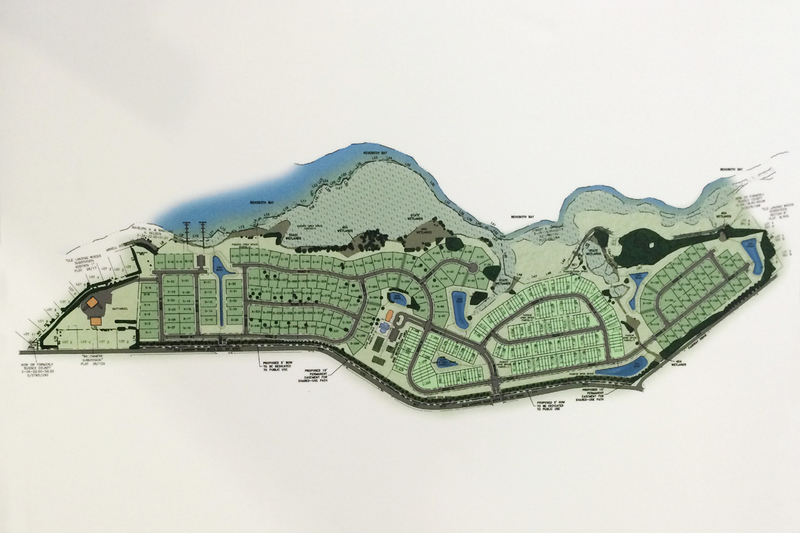The developer of the controversial Osprey Point development planned for the Old Landing Golf Course presented a slightly reduced plan to Sussex County Council Feb. 3, eliminating 10 homes from the project.
While location of those lots was a point of contention for some of the opposition, those who spoke against the project at a county council rezoning public hearing said the minor reduction is not enough.
Osprey Point D LLC has filed an application for a zoning change from AR-1, agricultural-residential, to MR-RPC, medium density, residential planned community, for a 127-acre parcel along Old Landing Road. The Osprey Point plan features 180 townhomes and 160 single-family homes. Attorney Jim Fuqua said 10 single-family lots were removed and four others were relocated within the property. Those lots were primarily located along Fairway Drive.
For nearly six hours, the developer and opposition laid out arguments for and against rezoning. The developer says the plan meets the county's requirements to allow rezoning, while opponents produced a long list of concerns they believe warrant further investigation.
“A land-use application is not a popularity contest,” Fuqua said. “Land-use decisions are based on the applicable land-use laws and regulations, which set forth specific criteria to guide the landowner and the county council in determining legally permitted development.”
Williams Dunn, an attorney working pro bono for a group of residents against the project, asked council to deny the request and urge the applicant to resubmit a plan in its current AR-1 zoning. He said the developer's plan should contain lower density, greater open space, appropriate stormwater management and a plan to mitigate traffic.
“While the applicant has the right to develop his property, current and future residents have the right to a well-planned and safe community,” he said.
Both the developer and opponents presented their cases in January to the county's planning and zoning commission. The commission chose to defer judgement and has not yet rendered its decision.
Property owner Robert Marshall has owned the property since 1991, but the property has been owned by the Marshall family for nearly a century. The first nine holes of the golf course were developed in 1960, with the second nine added in 1968.
Davis, Bowen & Friedel engineer Zack Crouch said when the golf course was constructed there were no requirements for stormwater management. It is his opinion that when the golf course is developed into a residential subdivision, frequent flooding on the property will be alleviated by the project's stormwater management plan.
Rich Morgante, president of the Old Landing Woods Homeowners Association, displayed photographs to illustrate the flooding issues on and around the golf course. He said an ordinary rain storm can cause flooding. He also showed photographs of the area during Hurricane Sandy in 2012 to solidify his point that certain areas of the property should not be developed.
“These storms are not happening once in a lifetime, these storms are happening every couple of years, and that is why we're concerned,” he said. “What happened in Sandy is going to happen again.”
Osprey Point developers are moving forward with a stormwater management plan based on old stormwater management regulations. New regulations were implemented by the Department of Natural Resources and Environmental Control Jan. 1, 2014. Many projects, including Osprey Point, were grandfathered and have until July 1, 2015, for plan approval.
Opponents say it is unlikely the project will gain final approval by the deadline, and the developer should create a stormwater management plan under the new regulations.
Leslie Ledogar, an environmental attorney with 15 years of experience in the field, says there are many red flags in the proposed plan. She said the plan conflicts with the county's comprehensive plan and is improperly proposed to be built in a flood zone and on poorly draining hydric soils. If the plan moves on as proposed, she said, she is also concerned it may have a significant impact on neighboring wells.
“We're not saying no to the development; we're saying smart development,” she said. “In the end, we're all neighbors. And in the end, this is our environment; this is our home, and it is our future.”
One of the big points of contention has been the traffic Osprey Point could bring. Traffic engineer D.J. Hughes of Davis, Bowen and & Friedel, working on behalf of the developer, does not disagree that the plan will add traffic; however, he said, traffic at the intersection of Warrington and Old Landing roads does not back up coming from the proposed development.
Traffic studies show, he said, that the left turn lane on Warrington Road should be extended and a traffic light should be installed at the intersection with Old Landing Road. Those improvements, he said, are entirely at the discretion of the Department of Transportation.
An argument has been made that the most recent traffic impact study was completed in 2011. While that is technically true, Hughes said, he submitted a 1,000-page traffic operational analysis in December that included studies of the area from 2013 and 2014.
His report estimates that planned developments on Old Landing Road will produce 800 more units over the next 10 years and increase traffic 16 percent.
DelDOT representative William Brokenbrough addressed the public's call for a traffic impact study at county council's meeting. He said the 2011 study was not a traffic impact study by definition, but it did provide his agency with a good understanding of how the intersections in the area will operate over the next few years. He said the developer argued and DelDOT agreed that they could do something less than a full traffic impact study.
“We therefore have a little less information than we would have, but I think we still know enough to say what the developer should be required to do in terms of improving the intersections,” he said.
County council is keeping the record open to receive reports requested by the planning and zoning commission and to have an official familiar with soil conservation regulations address council regarding issues specific to the Osprey Point property. After those occur, the record will be held open an additional 20 days for the public and applicant to respond.
Nick Roth is the news editor. He has been with the Cape Gazette since 2012, previously covering town beats in Milton and Lewes. In addition to serving on the editorial board and handling page layout, Nick is responsible for the weekly Delaware History in Photographs feature and enjoys writing stories about the Cape Region’s history. Prior to the Cape Gazette, Nick worked for the Delmarva Media Group, including the Delaware Wave, Delaware Coast Press and Salisbury Daily Times. He also contributed to The News Journal. Originally from Boyertown, Pa., Nick attended Shippensburg University in central Pennsylvania, graduating in 2007 with a bachelor’s degree in journalism. He’s won several MDDC awards during his career for both writing and photography. In his free time, he enjoys golfing, going to the beach with his family and cheering for Philadelphia sports teams.

























































